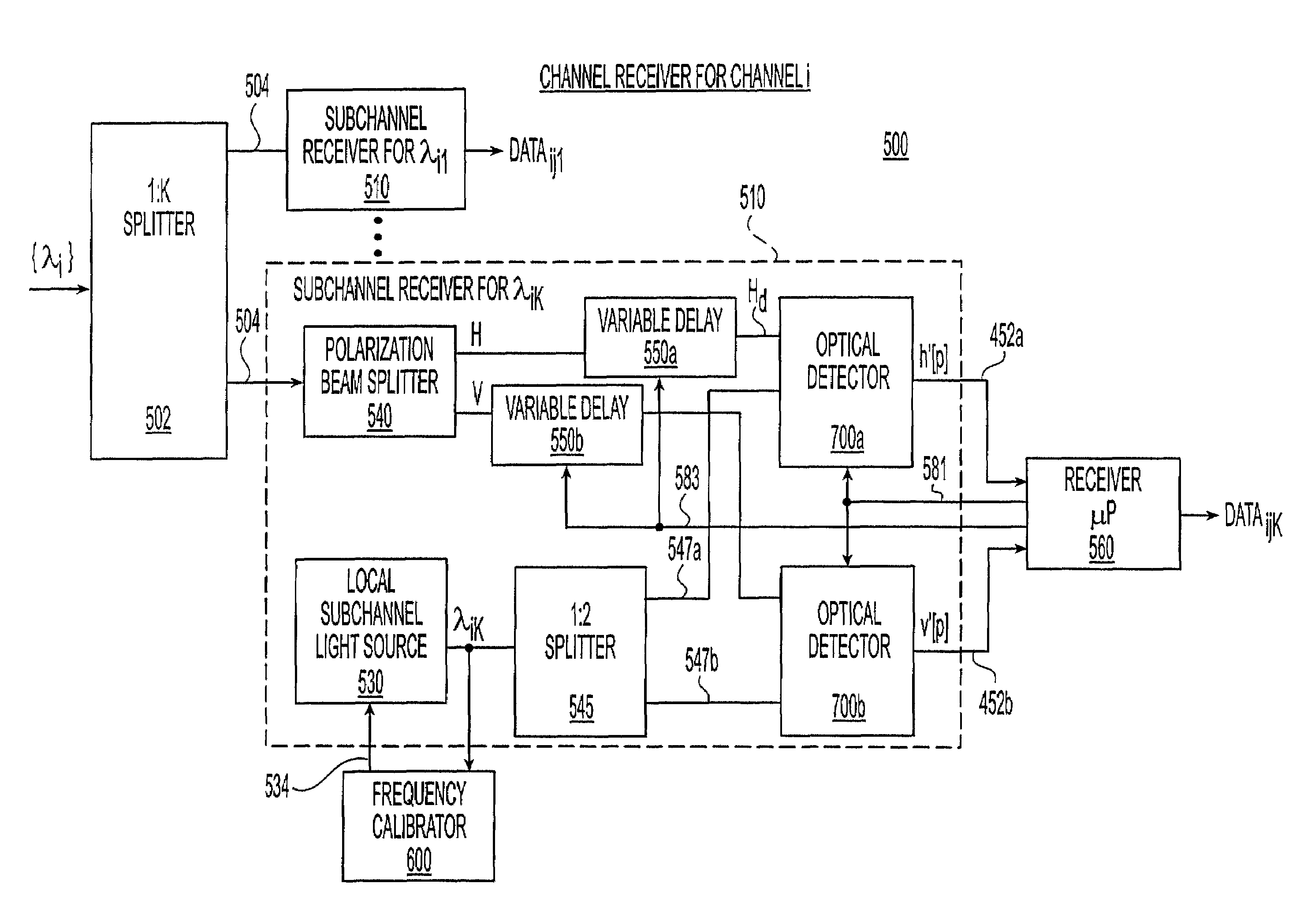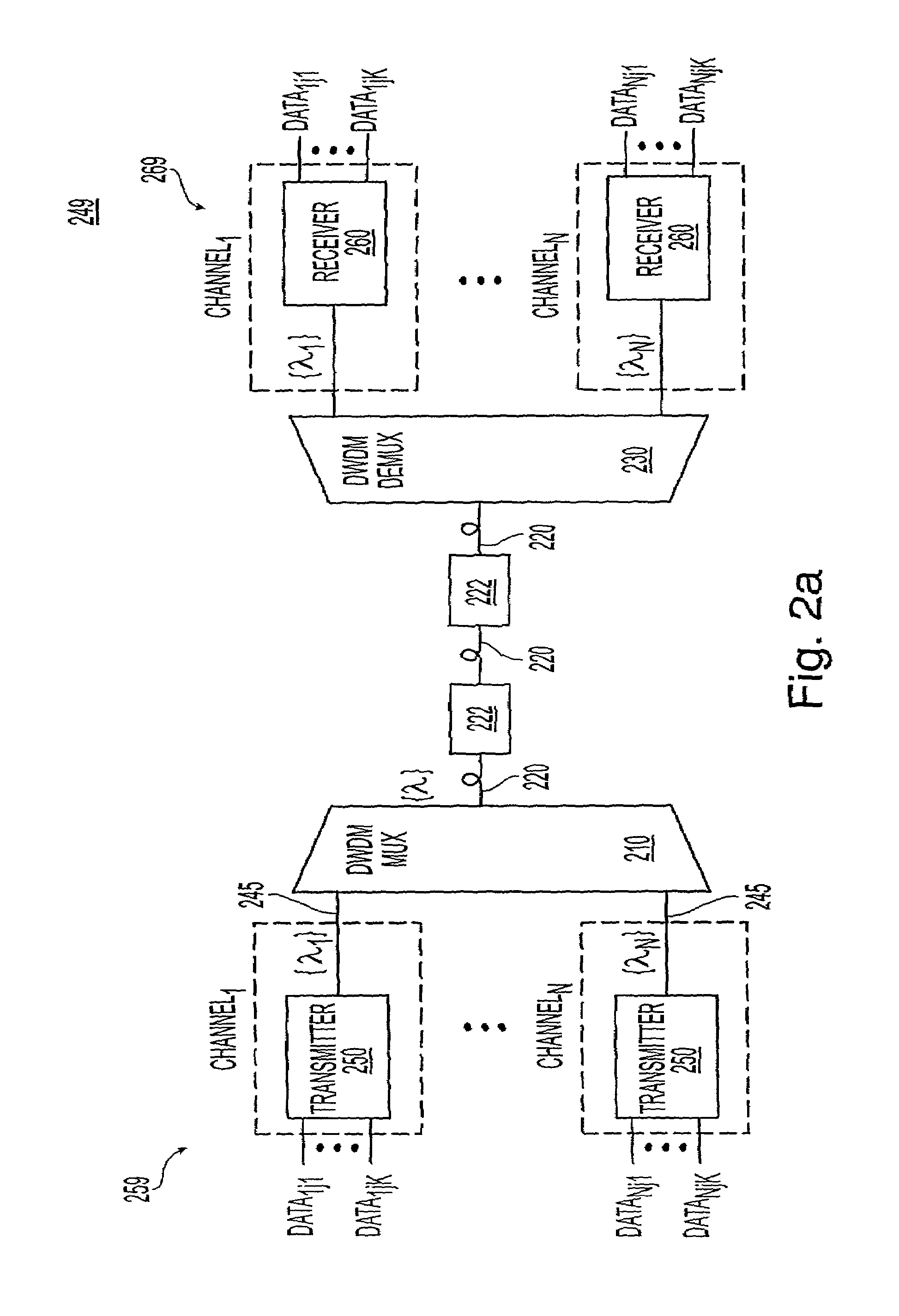System and method for orthogonal frequency division multiplexed optical communication
a technology of orthogonal frequency division and optical communication, applied in the field of optical communication systems, can solve the problems of increasing the data modulation rate, increasing the number of channels per fiber, and increasing the cost of semiconductor technology and other issues, to achieve the effect of reducing the cost of optical communication receivers and eliminating artificial signals
- Summary
- Abstract
- Description
- Claims
- Application Information
AI Technical Summary
Benefits of technology
Problems solved by technology
Method used
Image
Examples
second embodiment
[0056]FIG. 3b is a block diagram of a transmitter 1400. The transmitter 1400 employs a single light source 1402 that puts out a plurality of evenly spaced-apart spectral lines, separated by some frequency spacing Δf. Preferably, the single light source 1402 puts out K such spectral lines, each being used as a subchannel light beam 332. This allows one to employ a single light source 1402 to provide the illuminating beam. The evenly spaced-apart spectral lines in the frequency domain, may be regarded as the teeth of a “comb”, and so such a light source may be referred to as a ‘comb generator’. U.S. Pat. No. 4,096,448 to Hayes and U.S. Pat. No. 5,347,525 to Fans, whose contents are incorporated to the extent necessary to understand the present invention, exemplify systems for creating optical signals having evenly spaced-apart frequencies.
[0057]In the transmitter 1402 of FIG. 3b, the comb generator 1402 preferably includes circuitry to ensure even frequency spacing between the teeth. ...
first embodiment
[0065]FIG. 5a is a block diagram of a channel receiver 500, of the sort that can be used as the receiver 260 in FIGS. 2a &2b. The nomenclature used to describe receiver 500 corresponds to a receiver for channel i.
[0066]The channel signal {λi} from the DWDM demultiplexer 230, which carries K subchannel signals each having a data stream with both H and V components, is directed into a 1:K receiver splitter 502 that splits the optical channel signal into K identical receiver channel signals 504. Each of the identical receiver channel signals 504 is input to one of K subchannel receivers 510, each subchannel receiver 510 being configured to detect one subchannel {λik}. For purposes of clarity, only one subchannel receiver 510 is shown in detail in FIG. 5a.
[0067]The receiver channel signal 504 is first directed into a polarization beam splitter 540 which splits the incoming signal into two orthogonal components, designated ‘H’ and ‘V’. The H- and V-components are subjected to variable d...
third embodiment
[0108]FIG. 11c presents a self-homodyne receiver 1100c having self-homodyne sub-channel receivers 110c. This self-homodyne embodiment has a multiple PMD compensators and multiple polarization beam splitters. In self-homodyne sub-channel receiver 1110c, The sub-channel signal 1104 is first input to a 1:2 splitter 1142 to produce two identical sub-channel signals 1104a, one of which is delayed by a one-symbol delay 1144 to produce delayed sub-channel signal 1105a.
[0109]The sub-channel signal 1104a and the delayed sub-channel signal 1105a are input to a 90° optical hybrid circuit 1200 which outputs the four combined signals 731, 735, 733 and 737. The 90° optical hybrid circuit 1200 found in sub-channel receiver 1110c does not have to be polarization sensitive, since it does not receive the polarization beam-split signals. However, it would not hurt to use a polarization-sensitive 90° optical hybrid circuit. The four combined signals 731, 733, 735 and 737 represent the four complex cr...
PUM
 Login to View More
Login to View More Abstract
Description
Claims
Application Information
 Login to View More
Login to View More - R&D
- Intellectual Property
- Life Sciences
- Materials
- Tech Scout
- Unparalleled Data Quality
- Higher Quality Content
- 60% Fewer Hallucinations
Browse by: Latest US Patents, China's latest patents, Technical Efficacy Thesaurus, Application Domain, Technology Topic, Popular Technical Reports.
© 2025 PatSnap. All rights reserved.Legal|Privacy policy|Modern Slavery Act Transparency Statement|Sitemap|About US| Contact US: help@patsnap.com



